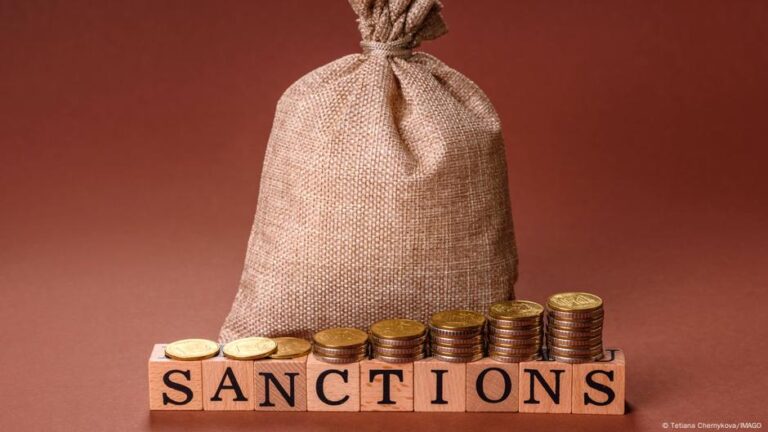For more than three years, Western observers have puzzled over the true state of Russia’s economy. At times, it has appeared to buckle under the strain of sanctions — at others, it has shown unexpected strength.
In 2023, Russia’s gross domestic product (GDP) rose by 4.1%, and in 2024, by 4.3%.
However, the momentum, largely fueled by the shift to a wartime economy, now appears to be fading. Many economists expect Russia’s growth to be cut in half, dropping to just 2%. For instance, Germany’s Kiel Institute for the World Economy projects GDP growth of only 1.5% for 2025 and just 0.8% for 2026.
Even the Russian central bank is expecting a slowdown, Russian state news agency Interfax reported recently, sticking to its lower forecast of between 1% and 2% growth for 2025, and 0.5% to 1.5% next year.
The Munich, Germany-based ifo Institute is even more pessimistic, predicting that after a modest uptick in 2025, Russia’s economy will contract by 0.8% in 2026.
Russia’s war economy faces challenging conditions
One major drag is Russia’s exorbitantly high interest rate, currently 21%, which is choking off private investment. The auto industry and mechanical engineering sectors are particularly hard hit, followed by construction and steel.
At the same time, the roughly 40% gain of the Russian currency ruble against the US dollar since the start of the year has surprised many analysts.
According to Vasily Astrov, a Russia expert at the Vienna Institute for International Economic Studies (WIIW), the ruble appreciation was largely a response to US President Donald Trump’s conciliatory stance toward Russia.
“When President Trump took office, he said he would take a radically different approach to Russia than his predecessor, Joe Biden,” Astrov told DW. Trump had hinted at closer cooperation and even a loosening or repeal of US sanctions, which triggered “euphoria” on Russian financial markets, with stocks and the ruble both “appreciating significantly,” Astrov said.
Will euphoria vanish on tighter bank sanctions?
In November 2024, the US toughened sanctions on Gazprombank, a major Russian belonging to the state-owned energy giant, excluding it from the US financial system. The move froze its US assets and cut off business with American firms. Gazprombank is central to processing gas payments and financing military-related projects.
While the European Union had exempted Gazprombank from sanctions until the end of 2024 to allow continued payments for Russian gas, the US move had an immediate impact. The ruble lost a quarter of its value against the dollar, and the stock market plunged, especially in the financial and energy sectors.
It was no surprise, then, that Russian policymakers paid close attention when Donald Trump, after a late-April meeting with Ukrainian President Volodymyr Zelenskyy in Rome, hinted it might be time to “deal with [Putin] differently.” Trump’s likely Russia policy U-turn reportedly includes new measures targeting the banking sector as well as so-called secondary sanctions.
US Senate prepares new sanctions legislation
Trump’s threat of “secondary sanctions” refers to penalties imposed on third countries, companies, or individuals who continue doing business with Russia.
Trump ally Senator Lindsey Graham responded to Trump’s remarks with a post on X, writing that he and a bipartisan group of nearly 60 senators were preparing legislation to expand sanctions to any country importing Russian energy products.
The bill, Graham noted, would impose secondary tariffs on countries buying Russian oil, gas, uranium, or other products.
Astrov says Graham’s new Russia sanctions bill could be targeting China and India primarily.
“China is now Russia’s most important trading partner, accounting for around 40% of its imports and 30% of its exports in 2024. Crucial imports for the military industry are routed through China and Hong Kong,” said Astrov.
India also played a key role in propping up the Russian economy, he added, as China and India together “absorb more than half of Russia’s total oil exports.”
While China’s refusal to join Western sanctions was expected and India’s neutrality also came as no major surprise, the unexpected player in the sanctions game was Turkey, he said, because the country also declined sanctions despite being a “NATO member and part of a customs union with the European Union.”
Russia’s payment channels face shutdown
Under President Biden, secondary sanctions were strictly enforced, and violations were punished. Astrov notes that especially Chinese and Turkish banks that accepted payments from Russia came under heavy pressure from the Biden administration.
The Trump administration, however, changed the policy, for example, by disbanding the department within the finance ministry that is responsible for targeting Russian oligarch assets and by “massively easing” the enforcement of secondary sanctions.
Astrov thinks it’s currently “difficult to predict” how deeply new secondary sanctions under a second Trump administration would affect Russia’s economic partners.
One reason for this was recently reported by the Reuters news agency. Reuters said that major Russian banks have set up a netting payments system dubbed “The China Track” for transactions with China, aiming to “reduce their visibility to Western regulators and mitigate the risk of secondary sanctions.”
Banking sources told Reuters the system has been operational for some time and is used by several sanctioned Russian banks. It relied on intermediaries in countries still willing to trade with Russia and had “not yet suffered any major setbacks,” according to Reuters.
“I do not rule out that the Chinese partners will no longer be afraid of secondary sanctions,” Reuters quoted Alexander Shokhin as saying — the head of the powerful RSPP business lobby group, who takes part in trade negotiations with China.
This article was originally written in German.


